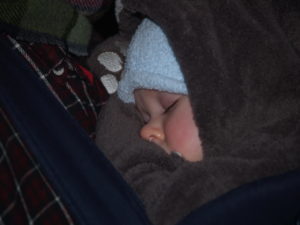At Birth, What Does Your Baby Know and Feel?
From birth, infants live in a two-person social world—you and your baby.
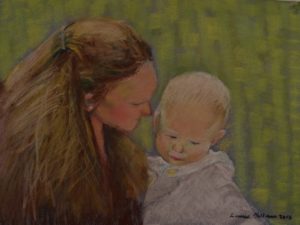
That is, they coordinate their behaviors with those of their primary caretaker, who will play with them from the very start.
You will notice how they are alert from their first moments after birth and have active minds and multiple physical and emotional needs. Parents can encourage their babies to learn during their baby’s first twelve months—How? Mostly through play!
The VALUE OF PLAY
Babies are dazzling, brilliant, and smart learners. Through play, you can learn how your baby’s mind works, how to relate to her, and how to engage with her.
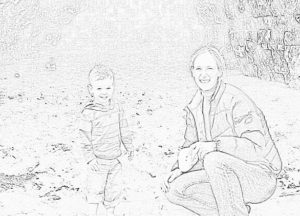
As you will see, babies are looking to interact and engage from the beginning. Yes! From the absolute beginning! At birth, they can differentiate human faces and voices from other sights and sounds—and they prefer them.
WHO BABIES RECOGNIZE AT THE GET-GO
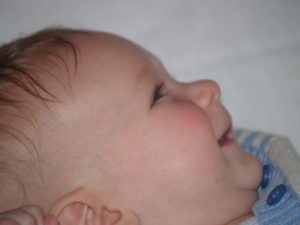
Within a few days, babies recognize familiar faces, voices, and smells and prefer them to unfamiliar ones. So, they choose you over others with their gazes.
Remarkably, a baby’s line of sight or vision is most clearly focused at the distance of a person holding them. It’s as if they are “designed to see the people who love them more clearly than anything else.” How wonderful!
THE MAGIC OF NOVELTY

Babies love novelty. If they see the same picture over and over, they lose interest. Show them something else, and they perk right up!
Babies recognize new and repeated noises. As a newborn, if a baby hears a noise, he will look in that direction, suggesting he already expects to see something to which the noise directed him to.
Babies Connect Sound and Vision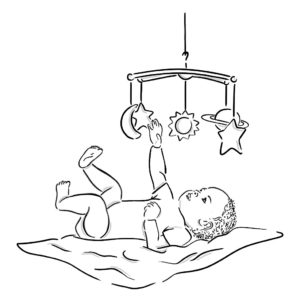
By five months old, their minds are even more complex, discriminating between what sound goes with what object or face.
Then by the time they are nine months old, they have discovered that something hasn’t disappeared when it’s been covered or hidden from view. They discover this through repetition. What a fun year of progression you have ahead of you!
Babies do what they see! They are attuned to people and are active imitators early on. Stick out your tongue at a baby, and she will stick out her tongue at you. Similarly, open your mouth and your infant will open hers. This is at one month old! How fast babies learn from us.
“In order to imitate, newborn babies must somehow understand the similarity between an internal feeling and the external face they see, like a round shape with a long pink thing at the bottom moving back and forth [the tongue].”
Further, babies seem to know things have three dimensions. They know that something that looks curved also feels curved!
Babies Recognizing their Personal Self
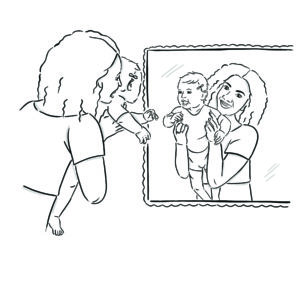
From the time they are born they seem to be in touch with their movements, aches, and tickles. This is a very early recognition of their personal self.
From birth, they also sense somehow that their bodily movements of that growing personal self are like yours. So, they notice movements of yours they can see yet not feel.
Other Aspects of the Environment Babies Key Into
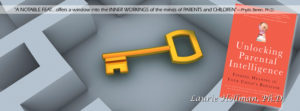
While we know that babies love human voices and faces, they also show interest in stripes and edges. You can show your babies different pictures and notice where they look. Babies turn toward complex patterns such as stripes with high contrast—not simple patterns with little contrast.
For example, they love checkerboards and bull’s-eyes. Babies also notice the differences between the brightness and texture of two surfaces and where objects begin and end. So, they can identify edges, allowing them to separate different objects.
Babies also learn from watching things move, which provides more clues about where things begin and end than edges alone. Even young babies can follow the movements of an object right in front of them. Remarkably, they also seem to be able to predict where an object will move in the future.
In an experiment, a ball was rolling and rolled behind a screen. The baby, who was watching, expected to see the ball come out from the screen’s other side. If the ball never emerged, the baby looked even longer and more intently to the edge of the screen—where the ball should have gone.
Or, she even looked on the path the ball should have taken. It’s as if she was able to predict where the ball should be if it rolled behind the screen, if it rolled beyond it, and when it should get there.
Babies also seem to discriminate between a ball that is close up or far away, as well as, when an even bigger ball is close and far. In other words, they understand size constancy!
Babies Recognize Different Emotions
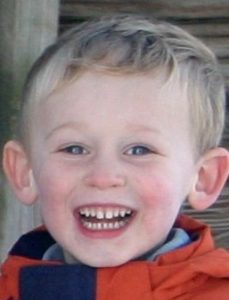
Babies can discriminate between different emotions on people’s faces and hear the different voice tones that correspond with them, such as happy, sad, and angry.
By one year, they discriminate people from objects and look to their mothers as a reference to know what to prefer and what to reject. For example, if a grown-up looks into two boxes and shows a happy face when she looks in one and a disgusted face at the other, the baby will prefer the box with the happy expression linked to it. The baby doesn’t only recognize the grown-up feels happy or disgusted, but also that she feels this about something in particular.
Imitation of Actions

Additionally, one-year-old babies can remember past actions and imitate them.
For example, when an experimenter touched the top of a box to his forehead, it lit up. The baby could watch but not touch the object. One week later the babies were given the same box, and they instantly touched their foreheads to the top of the box.
How memory is working so early on is fantastic.
